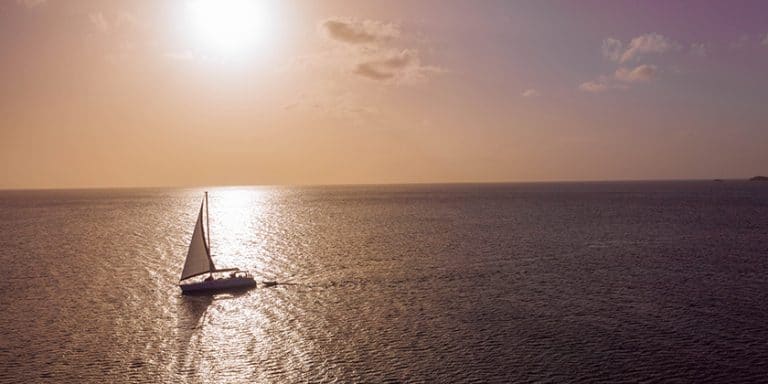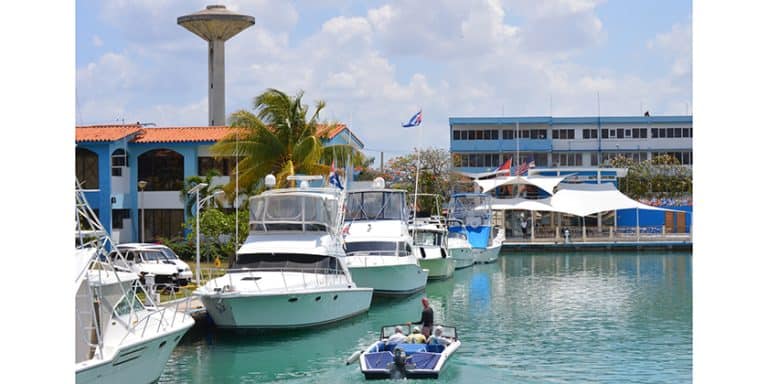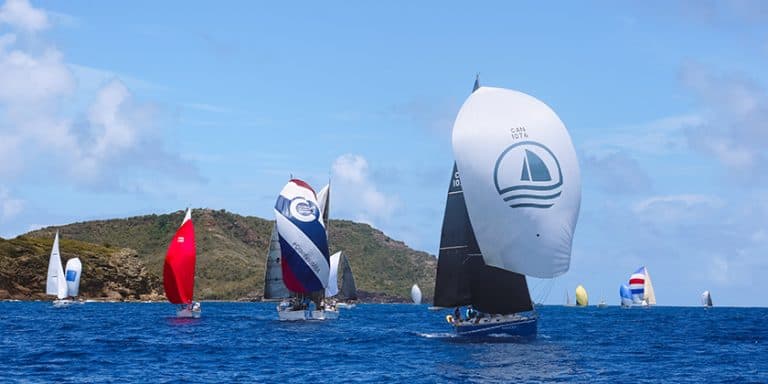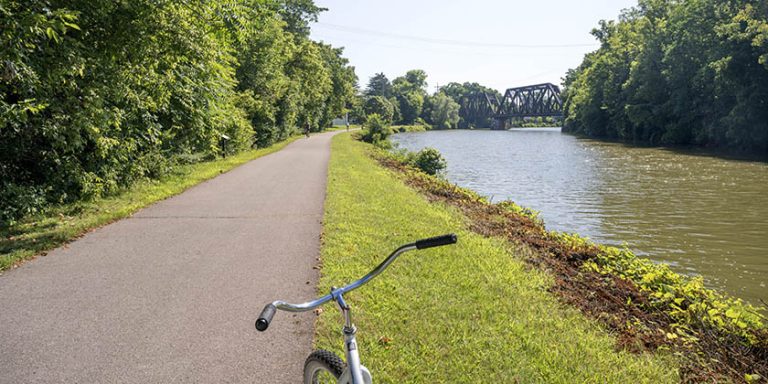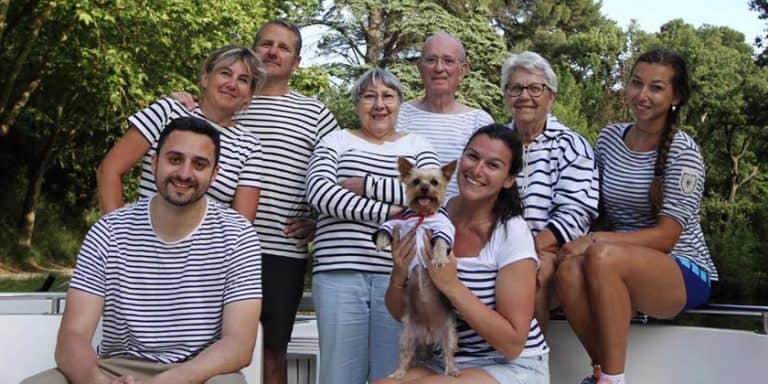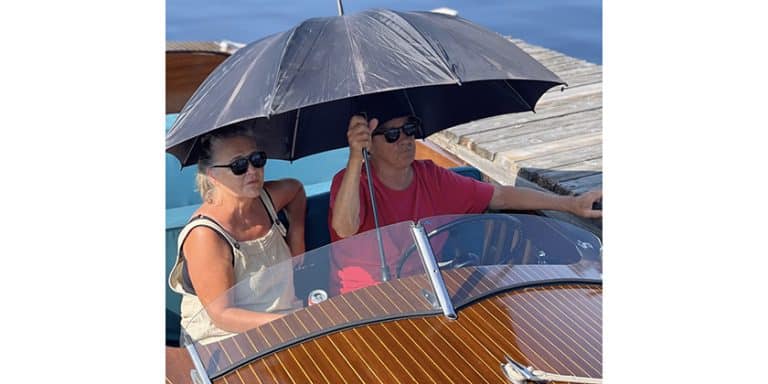Canary Islands – Staging Area for Atlantic Crossings Through the Ages
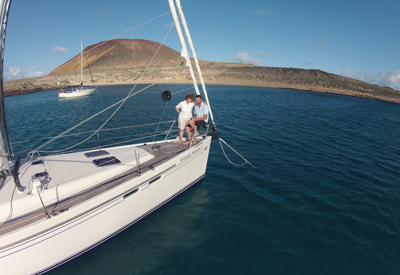
By Paul and Sheryl Shard
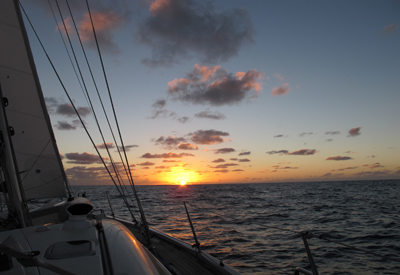 Sailing offshore from Rabat, Morocco, 450 nm to the southwest to Isla Graciosa, Canary Islands, aboard their Southerly 49 sailboat, Distant Shores II, the Shards get lovely sunrises and sunsets at sea each day. The passage is a nice length – long enough for a good offshore shake-down but short enough to get a fairly dependable weather forecast. Photo by Sheryl Shard
Sailing offshore from Rabat, Morocco, 450 nm to the southwest to Isla Graciosa, Canary Islands, aboard their Southerly 49 sailboat, Distant Shores II, the Shards get lovely sunrises and sunsets at sea each day. The passage is a nice length – long enough for a good offshore shake-down but short enough to get a fairly dependable weather forecast. Photo by Sheryl Shard
I don’t know what I expected the first time we made landfall in the Canary Islands but I have to admit that after sailing from the lush mid-Atlantic island of Madeira, I was seriously surprised when the barren desert-like landscapes of the Canary Islands came into view.
Introduction to the Canary Islands
The Canary Islands are a mid-Atlantic archipelago lying only 70 nm off the African coast at it’s closest point. An autonomous community of Spain, the Canary Islands lie at the outermost point of the European Union recognized for their historical significance. Sailors recognize them as a great year round cruising ground and staging area for transatlantic passages to the Caribbean.
 Cruising boats arrive in the Canary Islands from all countries around the world and anchor at Playa Francesa. The steep cliffs of the island of Lanzarote lie across the narrow strait, Estrecho del Río, in the background. The strait is popular with migrating pilot whales.
Cruising boats arrive in the Canary Islands from all countries around the world and anchor at Playa Francesa. The steep cliffs of the island of Lanzarote lie across the narrow strait, Estrecho del Río, in the background. The strait is popular with migrating pilot whales.
Photo by Sheryl Shard
The archipelago stretches across approximately 7,300 square km of sparkling Atlantic water and consists of 7 main volcanically formed islands. Ancient sedimentary formations show that geologically they were once part of the African continent but volcanic activity throughout the millennia has shaped the landscape creating steep-sided cliffs, deep water-eroded gorges and semi-desert regions on many of the islands.
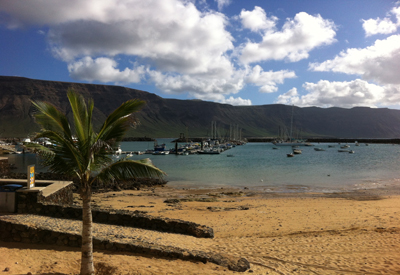 Although dry and desert-like, Isla Graciosa is one of the most appealing islands in the Canary Island Archipelago since it is so undeveloped and peaceful. There are many trails and walking is great exercise after being at sea. There are 4 volcanic cones, the highest 265m high, giving the island an lunar landscape appearance. Photo by Sheryl Shard
Although dry and desert-like, Isla Graciosa is one of the most appealing islands in the Canary Island Archipelago since it is so undeveloped and peaceful. There are many trails and walking is great exercise after being at sea. There are 4 volcanic cones, the highest 265m high, giving the island an lunar landscape appearance. Photo by Sheryl Shard
I had heard about the Canary Islands as a school girl when we had learned about the great explorers of days gone by. The Canary Islands were a jumping-off point for many of these adventurers such as Christopher Columbus and his crews. Their fleets stocked up on lumber for boat repairs as well as fresh food and water here before sailing off across a vast and unknown sea to discover new worlds. I imagined waterfalls, lush fields and forests full of tall trees, exotic plants and bright yellow birds.
Like most people, the name had fooled me. The Canary Islands were not named for canary birds although you do find these bright yellow birds flitting around the islands along with many other beautiful indigenous and migrating birds. In fact, with over 200 recorded species, bird-watching is a popular draw for many visitors to the Canary Islands as are the many great beaches and the pleasantly warm climate during the winter months.
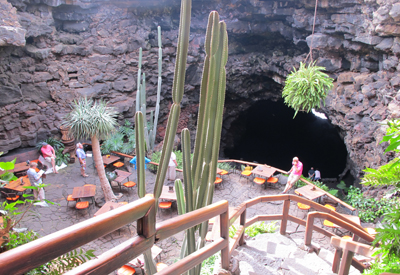 The Jameos was conceived by island-born artist and architect, Cesar Manríque, during the 1960‘s “fusing art with nature in Lanzarote” to create a unique cultural attraction. Using volcanically formed caves and lava tubes he created unique spaces to dine in, explore and visit. You enter the Jameos del Agua, a former lava tube open at both end down a stone staircase to a bar/restaurant overlooking another cave containing a small lake. Photo by Sheryl Shard
The Jameos was conceived by island-born artist and architect, Cesar Manríque, during the 1960‘s “fusing art with nature in Lanzarote” to create a unique cultural attraction. Using volcanically formed caves and lava tubes he created unique spaces to dine in, explore and visit. You enter the Jameos del Agua, a former lava tube open at both end down a stone staircase to a bar/restaurant overlooking another cave containing a small lake. Photo by Sheryl Shard
The name of the Canary Islands is most likely derived from the Latin name, “Canariæ Insulæ”, meaning “Islands of the Dogs”. Another thought is that the ancient Romans who first arrived in these islands by sea were referring to the abundance of monk seals populating the islands at the time. “Canis marinus” is Latin for “sea dog”. More theories are that the aboriginal people are said to have called themselves “Canarii”. There is a Berber tribe living in the Atlas Mountains of Morocco, the closest mainland to the archipelago, who the Romans referred to as “Canarii”. Is there a connection? Regardless of where the name came from, the connection to dogs is retained on the islands’ coat-of-arms, so it seems that the islands do not take their name from the canary bird, rather, the birds are named after the islands!
Despite the many dry desert-like landscapes there are still forested areas throughout the islands and fertile lands for growing fruits and vegetables, but when arriving from sea the tall volcanic peaks are the first things that show themselves on the horizon. El Tiede on the main island of Tenerife is a gigantic volcanic cone that rises to 3,717 m and is often snow-capped. The strong winds blowing sand off the Sahara desert on the nearby African coast make farming a challenge (but create the great beaches) so many plants are grown in enormous greenhouses for protection. When approaching the Canary Islands from sea, be prepared for your sails, deck and standing rigging to get covered with fine red Sahara sand although you are hundreds of miles from land.
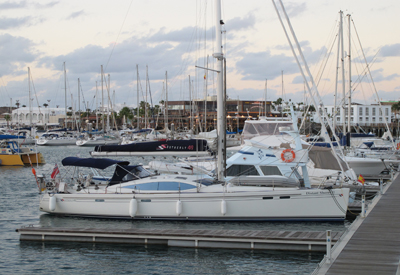 Marina Rubicón is quickly becoming a popular alternative to the marina in Las Palmas, Gran Canaria, where rallies such as the Atlantic Rally for Cruisers take over the marina in the autumn months and space for transient yachts is unavailable. Marina Rubicón however has over 500 berths and nearly half are reserved for visiting yachts up to 70m LOA. The marina is surrounded by facilities and services for sailors as well as numerous shops and restaurants which is great after being at sea for a while. Photo by Sheryl Shard
Marina Rubicón is quickly becoming a popular alternative to the marina in Las Palmas, Gran Canaria, where rallies such as the Atlantic Rally for Cruisers take over the marina in the autumn months and space for transient yachts is unavailable. Marina Rubicón however has over 500 berths and nearly half are reserved for visiting yachts up to 70m LOA. The marina is surrounded by facilities and services for sailors as well as numerous shops and restaurants which is great after being at sea for a while. Photo by Sheryl Shard
Canary Islands – Staging Ground for a Transatlantic Crossing
Our first visit to the Canary Islands was in 1991 aboard our first boat, Two-Step, a Sparkman and Stephens design called a Classic 37 that my husband Paul, and I had built together from a bare hull and deck. We cruised internationally aboard that boat for 18 years sailing 60,000 nm including 3 transatlantic crossings.
Like Christopher Columbus before us, when we sailed to the Canary Islands, we were using the islands as a staging area before jumping off to cross the Atlantic Ocean to the islands of the Caribbean. The interior space of the Classic 37 was small and we did the crossings with just the two of us on board. It was pretty tiring.
Since then, we have sailed to the Canary Islands on four other occasions over 28 years of cruising and living aboard. The second time was in 2007 aboard our second boat, a British-built variable-draft Southerly 42 called Distant Shores. Joining us as crew were cruising friends, Wayne and Angie, which made that Atlantic crossing more fun. With extra crew, everyone gets more sleep and there are people to talk to when you are off-watch.
Transatlantic Rallies
Our next boat was another Southerly, a 49 called Distant Shores II, which we cruised aboard for 7 years putting 25,000 nm under the keel. We sailed to the Canary Islands from Morocco on Distant Shores II and, to make a change for our 5th transatlantic crossing, we participated in the World Cruising Club’s Atlantic Rally for Cruisers (ARC), an annual event with over 200 boats sailing from Las Palmas, Gran Canaria, to St. Lucia in the Caribbean, a 2,800 nm passage. The seminars, safety checks and social activities involved in rallies are good fun and our friend, Matt, joined us as crew.
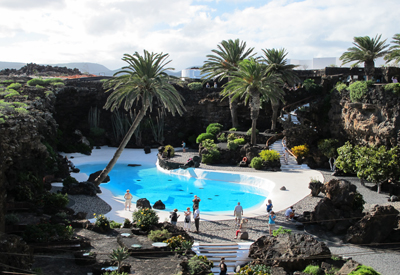 This crater is a good base for a swimming pool and unique accommodations. Photo by Sheryl Shard
This crater is a good base for a swimming pool and unique accommodations. Photo by Sheryl Shard
In 2015 we did another Atlantic Circle revisiting the mid-Atlantic islands of the Azores, Madeira and the Canary Islands. We joined ARC + that year, a version of the ARC that includes a stop in the Cabo Verde Islands, another Atlantic archipelago, which we had never explored until then. Friends, Doug and Anthony joined us as crew. ARC+ is a smaller fleet, popular with cruising families since the distance to the Caribbean is broken up by the stop in Cabo Verde giving everyone a better chance to get their sea legs.
ARC and ARC+ rally fleets take over the city marina in Las Palmas, Gran Canaria, for most of November every year, so if you are thinking of staging in the Canary Islands for a transatlantic crossing keep this in mind.
Best Time for Transatlantic Passages from the Canaries
Why is November the time so many boats leave for a transatlantic passage? The hurricane season is officially over in the Caribbean at that time and leaving the Canary Islands in November means that, all going well, you will be arriving in the Caribbean in time to celebrate the Holiday Season, a nice way to finish an ocean crossing. This also gives you a good start to a full winter of tropical island-hopping in the Caribbean. It’s not actually the best time, we feel, since the trade winds have usually settled in better if you leave a little later in December or January.
Having said that, we just did our 8th transatlantic crossing delivering a beautiful new Bluewater 50 catamaran from Las Palmas to St. Lucia leaving the Canary Islands in early November 2017. We had light winds, were becalmed several times and never saw a trade wind the whole time. We flew the spinnaker day and night and despite sailing a fast boat that handles light winds well, it was our longest transatlantic passage ever – 21 days from Las Palmas to St. Lucia! Friends Dave, Alexandra, Dan and Craig joined us. With six of us onboard, we each stood two 4-hour watches daily with two people on watch at a time, which made for good company, good sleep for all, and easy sail handling.
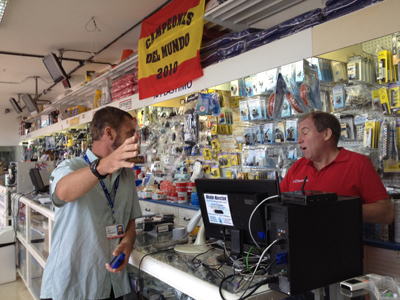 One of the reasons, Las Palmas is a popular spot for transatlantic sailors is that there are numerous excellent chandleries and services available right in the marina. Photo by Paul Shard
One of the reasons, Las Palmas is a popular spot for transatlantic sailors is that there are numerous excellent chandleries and services available right in the marina. Photo by Paul Shard
Cruising the Canary Islands
The Canary Islands are a great place to depart for the Caribbean with the numerous marinas and services for sailors to be found throughout the islands, fresh food markets and well-stocked grocery stores, but they are also a wonderful cruising ground unto themselves.
Many cruisers from all parts of the globe sail there for months at a time and some never leave, living aboard and cruising the islands all year round. Many Northern Europeans, both sailors and non-sailors, escape the cold here in wintertime just as Canadians head south to Florida, the Caribbean, and Mexico during the winter season. There is a large ex-pat community in these Spanish islands so English, German, and Scandinavian languages are widely spoken as well as Spanish. Bars, restaurants and grocery stores carry foods and beverages to cater to the tastes of these visitors which makes provisioning fun.
 Every November the marina at Las Palmas is taken over by participants of World Cruising Club’s Atlantic Rally for Cruisers (ARC). Over 200 boats leave together at the end of November to sail across the Atlantic to the Caribbean. Photo by Paul Shard
Every November the marina at Las Palmas is taken over by participants of World Cruising Club’s Atlantic Rally for Cruisers (ARC). Over 200 boats leave together at the end of November to sail across the Atlantic to the Caribbean. Photo by Paul Shard
Our favourite cruise of the Canary Islands followed a 3-day passage from Morocco aboard our Southerly 49, Distant Shores II before ARC 2012. We arrived at the northeast end of the archipelago at the small island of La Graciosa in a pastel sunrise and entered the narrow strait of Estrecho del Río that divides La Graciosa from the main island of Lanzarote. Pilot whales are often seen in this strait. La Graciosa is just 6.5 km long X 3 km wide and part of the Parque Natural del Archipiélago Chinijo. It is a real delight. It has a stark volcanic landscape but is quiet and laid-back, a contrast to more developed, though well-services areas, on the main islands where holiday resorts and marina bars offer late-night karaoke coming at you from several directions at once. We loved the hiking trails and deserted beaches of La Graciosa and felt blessed that as sailors we had access to such a treasure.
Our next stop was the main island of Lanzarote which is about 60 km long and 20 km wide and is known for its large dramatic lava plains and multitude of smooth volcanic cones. It is extremely dry. The 140,000 permanent residents rely on desalination plants for water since there is not enough rainfall on the island to sustain them otherwise.
At the end of a brisk daysail from La Graciosa, we rounded Punta Pechiguera at the southwest tip of Lanzarote and just 3 nm east of the lighthouse pulled into the large modern Marina Rubicón. When rallies such as the Atlantic Rally for Cruisers take over the marina in Las Palmas in the autumn months and space for transient yachts is unavailable, Marina Rubicón has over 500 berths and nearly half are reserved for visiting yachts up to 70m LOA. The marina is surrounded by facilities and services for sailors as well as numerous shops and restaurants which is great after being at sea for a while. Many sailors are making it their base and many sailors store their boats here when they need some time at home for part of the year.
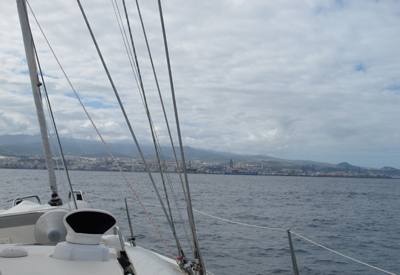 Following a 95 nm overnight sail from Marina Rubicón on Lanzarote, Distant Shores II arriving in Las Palmas, Gran Canaria. Photo by Sheryl Shard
Following a 95 nm overnight sail from Marina Rubicón on Lanzarote, Distant Shores II arriving in Las Palmas, Gran Canaria. Photo by Sheryl Shard
Lanzarote has been spared much of the development seen on some of the other larger islands such as Tenerife and Gran Canaria due to the efforts of island-born artist and architect, Cesar Manríque. In the 60’s, Manríque lobbied for “art to be fused with nature” to attract visitors rather than doing so by building water parks and golf courses. He created several unique spaces using volcanically formed caves and long open volcanic lava tubes. We visited the Jameos del Aqua that you enter by climbing down a long stone-staircase into a cave known as Jameo Chico. The cave has been turned into an unusual bar/restaurant overlooking a small lake in a second cave home to a species of blind albino crabs know as “Jameitos”, found on Lanzarote. There is also a swimming pool and accommodations built into the lava formations here.
 The large well-stocked grocery stores, such as HiperDino, in Las Palmas make provisioning for an ocean crossing easy. They also deliver to your boat. Here Angie gets ready to start stowing our supplies onboard our Southerly 42, Distant Shores. We provisioned at HiperDino for our crossing last November as well. Photo by Paul Shard
The large well-stocked grocery stores, such as HiperDino, in Las Palmas make provisioning for an ocean crossing easy. They also deliver to your boat. Here Angie gets ready to start stowing our supplies onboard our Southerly 42, Distant Shores. We provisioned at HiperDino for our crossing last November as well. Photo by Paul Shard
From Lanzarote we set sail for Gran Canaria to join in the preparations for the start of the ARC in Las Palmas. It’s a 95 nm passage from Marina Rubicón so we sailed overnight arriving at the fuel dock to check-in in daylight. Activities included tours of the island where we tasted local cuisine, planted trees for reforestation, attended cultural events where we tried traditional dancing and visited botanical gardens.
In previous years we have visited Tenerife to hike up the volcanic cone of El Tiede. There are good marinas in Tenerife also. We stopped at the small harbour in La Gomera and El Hierro on previous trips as well. We’ve yet to see La Palma and Fuertaventura but they are on our list for future visits!
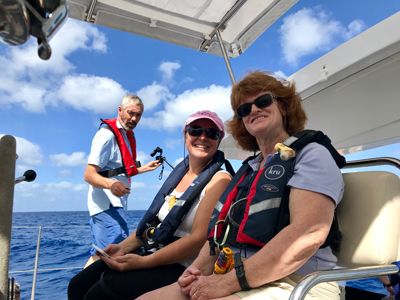
Paul, Alexandra and Sheryl aboard the Bluewater 50 catamaran last November.
Each island in the Canary Islands seems to have its own unique features and characteristics. I can understand why people keep returning to these islands. There is something magnetic about them. If you haven’t seen them, I hope you get the chance to travel there someday soon.
***
Canadians Paul and Sheryl Shard have now sailed over 100,000 nm and have completed 8 ocean crossings as well as many hundreds of miles of offshore passage-making on the three boats they’ve owned. They are currently having their 4th boat built, a new Southerly 480 which they helped design. They take delivery this spring and will be heading for the South Pacific. The Shards are award-winning filmmakers and television producers. You can see videos of their visits to the Canary Islands and transatlantic crossings as well as their many other adventures on the Distant Shores YouTube Channel at www.youtube.com/distantshores1.

